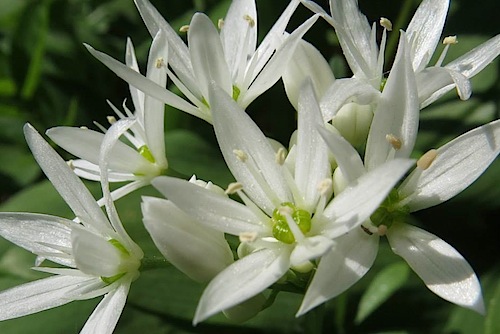
In spring and early summer, the garlic scent of Ramsons is everywhere in the deciduous woodlands, hedges and verges round the Lizard.
Photo: © Natural England/Peter Wakely
Scientific name: Allium ursinum
Other common names: Wild Garlic, Wood Garlic
What to look for:
- Family: Liliaceae (Lily family)
- Flowers: Flowerheads of white flowers, petals pointed in shape.
- Leaves and stem: 2 to 3 oval, pointed oval bright-green leaves growing from base.
- Height: 10 to 45 cm.
- Where: Across most of UK, in particular on richer, moist soils. The plant is found across Asia and Europe.
- When: Flowers April to June.
- Habit: Upright.
The white star-like flowers of Ramsons are often found in companionship with Bluebells. Both are plants that grow and flower in woodland before the canopy leafs up and blocks out the light. The contrast of the white and blue flowers, and of the garlic scent of Ramsons and the honey smell of Bluebells, makes for a lovely accompaniment to a woodland walk in the spring.
The species name for Ramsons – ursinum – is derived from the Latin for bear. Why would a pretty white plant, nodding in the woodland breeze, be named after a bear? Ramson bulbs are, in fact, a favourite of Brown Bears, which will dig up the ground to get at them, hence the plant’s species name.

Ramsons are traditionally a favourite of humans, too. A relative of chives, garlic and onions, they can be used to flavour our food. The bulbs, leaves and flowers are all edible, although they can be mistaken for some poisonous plants, such as Lily-of-the-Valley.
Did you know…?
…Ramsons are one of the plants used as an indicator of Ancient Woodland.

More information and references:
Rose, F. and O’Reilly, C., 2006. The Wild Flower Key, 2nd edition. Frederick Warne, London.
Stace, C., 2010. New Flora of the British Isles, 3rd edition. Cambridge University Press, Cambridge.
Published: May 2015
Author: Amanda Scott
Photos: Middle – Steve Townsend; others – © Natural England/Peter Wakely
